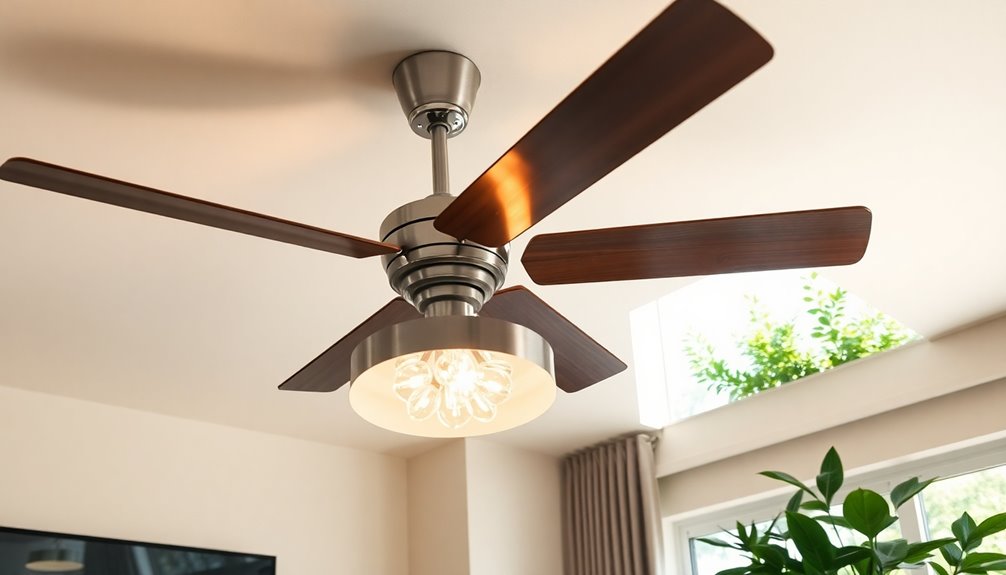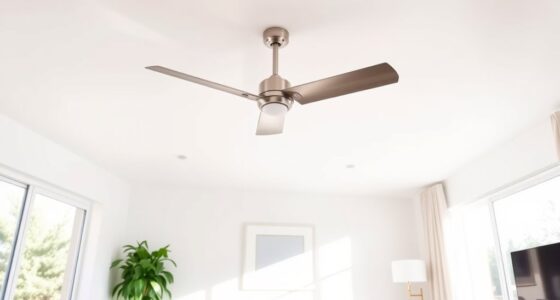A ceiling fan circulates air to create a cooling effect, enhancing comfort in your space. It doesn't lower the room temperature but creates a wind chill effect that helps you feel cooler. Fans with reversible motors can even help distribute warm air during winter, boosting energy efficiency year-round. You can raise your thermostat by up to 4°F without feeling discomfort, saving on energy costs, too. With various styles and features, you can find the perfect fan to match your decor. If you're curious about the many benefits and options, there's plenty more to explore.
Key Takeaways
- Ceiling fans create airflow, providing a cooling effect without lowering room temperature, enhancing comfort through the wind chill effect.
- They can reduce energy costs by allowing thermostat settings to rise by up to 4°F without a loss of comfort.
- Reversible motors enable fans to circulate warm air in winter, promoting energy savings of up to 60%.
- Running a ceiling fan is cost-effective, averaging about 14.85 cents weekly compared to higher air conditioning costs.
- Fans help improve air circulation in larger spaces, making them more efficient for cooling and comfort.
Understanding Ceiling Fan Functionality

Ceiling fans play an essential role in enhancing your comfort at home by creating airflow that makes you feel cooler without actually lowering the room temperature. The wind chill effect they produce enhances evaporative cooling, making you feel refreshed even on hot days.
Most ceiling fans come equipped with a reversible motor, allowing you to switch between counterclockwise rotation in the summer for a cooling breeze and clockwise rotation in the winter to recirculate warm air downwards, improving your comfort year-round.
The effectiveness of a ceiling fan largely depends on its design and speed; larger fans typically move more air and can cool larger spaces more efficiently. You'll find that Energy Star-rated ceiling fans operate at impressive energy efficiency, exceeding 100 cubic feet per minute (cfm) per watt of electrical power consumed. This not only helps you save on energy bills but also promotes energy conservation.
Continuous operation of your ceiling fan keeps the air fresh and prevents stagnation, greatly improving indoor air quality. Additionally, regular maintenance, such as inspecting for loose components, can ensure your ceiling fan operates safely and efficiently.
Types of Ceiling Fans

When choosing a ceiling fan, you'll encounter standard and specialty options tailored to your needs.
Standard ceiling fans suit most rooms, while specialty fans like chandelier or outdoor models add unique flair and functionality.
Understanding these types helps you find the perfect fan for your space.
Standard Ceiling Fans
Standard ceiling fans are versatile appliances that enhance comfort in your living spaces. They not only circulate air but also improve energy efficiency, making your rooms feel more pleasant year-round.
Here are some key features of standard ceiling fans:
- Blade Sizes: They typically range from 29 to 54 inches, fitting various room dimensions.
- Reversible Motors: You can switch between counterclockwise rotation for cooling in summer and clockwise rotation for warmth in winter, effectively recirculating warm air.
- Integrated Lighting: Many models come with light fixtures, providing both airflow and illumination in one unit.
- Efficiency Ratings: Look for ENERGY STAR® rated fans, which can deliver up to 40% more efficiency compared to conventional models.
Specialty Ceiling Fans
While standard ceiling fans effectively improve comfort and energy efficiency, specialty ceiling fans offer unique designs and features that cater to specific needs and aesthetics.
For instance, chandelier fans combine traditional lighting with fan blades, providing both illumination and air circulation in one elegant fixture. If you have low ceilings, low-profile fans are an excellent choice, offering a sleek appearance while ensuring effective airflow without sacrificing headroom.
When it comes to outdoor areas, outdoor ceiling fans are specifically built to withstand moisture and humidity, making them ideal for patios and covered spaces.
On the other hand, industrial ceiling fans are designed for commercial environments, featuring larger blade spans that efficiently move large volumes of air in high-ceiling areas.
If you're looking for modern convenience, smart ceiling fans integrate seamlessly with home automation systems. These fans allow you to control settings remotely, enabling you to adjust airflow and lighting for enhanced comfort and energy efficiency.
Installation and Mounting Options

Installing a ceiling fan requires careful consideration of various mounting options to guarantee safety and efficiency. You'll need to measure your ceiling height accurately to make sure the fan's lowest point remains at least 7 feet from the floor. Choosing the right mounting option enhances airflow efficiency and ensures peak performance.
Here are some common mounting choices:
- Low-profile fans: Ideal for ceilings under 9 feet, designed to sit closer to the ceiling.
- Standard mounts: Typically use a downrod of 3-5 inches for proper installation, keeping the fan at the right height.
- Extended mounts: Perfect for higher ceilings, these downrods can range from 6 to 120 inches to maintain safety and airflow.
- Angled mounts: Necessary for sloped ceilings, ensuring horizontal blade positioning while maximizing airflow.
A proper installation allows for an ideal airflow radius. To maintain peak performance, make sure to keep at least 18 inches from walls and 8-12 inches from the ceiling.
Energy Efficiency Benefits

Ceiling fans can greatly cut your energy costs while keeping you comfortable year-round.
By allowing your thermostat to rise without sacrificing comfort, you won't just feel cooler; you'll save money, too.
Plus, with smart fan features, you can optimize energy use even further, making your home more efficient.
Reduced Energy Costs
Often overlooked, ceiling fans can greatly reduce energy costs by enhancing your home's cooling efficiency. By allowing you to raise your thermostat settings by up to 4°F without sacrificing comfort, ceiling fans minimize your reliance on air conditioning.
Here's how they can save you money:
- Cost-Effective Operation: Running a ceiling fan averages about 14.85 cents weekly, while air conditioning can exceed $64.52.
- Efficiency Gains: ENERGY STAR® rated ceiling fans are up to 40% more efficient than conventional models, translating to significant savings.
- Low Power Consumption: Modern ceiling fans use only 3 to 10 watts on low speed, compared to air conditioning systems that can consume over 3,000 watts.
- Seasonal Benefits: Using ceiling fans to circulate warm air in winter can lead to energy savings of up to 60%.
Enhanced Comfort Levels
By improving air circulation, ceiling fans considerably enhance comfort levels in your home. You can raise your thermostat setting by up to 4°F without losing comfort, leading to significant energy savings on heating and cooling costs.
In the summer, running your ceiling fan in counterclockwise rotation creates a revitalizing cooling breeze, making your space feel much cooler without the need to lower the thermostat.
During winter months, you can switch the fan to clockwise rotation to recirculate warm air that naturally rises to the ceiling. This method guarantees even heat distribution, potentially reducing heating costs by up to 60%.
Operating ceiling fans at lower speeds also boosts energy efficiency, as they consume less power while still providing effective airflow—often exceeding 100 cubic feet per minute (cfm) per watt.
Opting for Energy Star certified ceiling fans can make a big difference, as they're designed to be up to 40% more efficient than standard models.
With ceiling fans, you not only enjoy enhanced comfort levels year-round but also contribute to lower energy bills.
Smart Fan Features
Here are some key benefits of smart fans:
- DC Motors: Smart fans typically use energy-efficient DC motors, consuming only 3-10 watts. This results in considerably lower energy bills compared to traditional AC motors. Furthermore, these motors can operate quietly, similar to air purifier performance that ensures minimal noise during use. Additionally, these modern designs often incorporate noise reduction technology, making them an excellent choice for maintaining a peaceful home environment. Moreover, using energy-efficient devices like smart fans can contribute to lower carbon emissions in your household. The integration of smart fans into your home can further enhance energy efficiency throughout your living space.
- Programmable Timers: Many models include programmable timers, allowing you to set the fan to operate only when you need it, minimizing unnecessary energy consumption.
- Home Automation Integration: Smart fans can sync with your home automation system, automatically adjusting based on room occupancy or temperature for ideal efficiency.
- App Control: With smartphone apps, you can remotely adjust speed settings and direction, maintaining comfort while allowing for higher thermostat settings, leading to energy savings of up to 4°F.
- Additionally, smart fans can be integrated with other smart home devices, enhancing overall energy management in your home.
Selecting the Right Fan

What Does a Ceiling Fan Do
Selecting the Right Fan
How do you choose the perfect ceiling fan for your space? Start by contemplating your room size. For spaces up to 400 square feet, ceiling fans with blade sizes ranging from 29 to 54 inches guarantee ideal airflow and comfort.
Next, think about energy efficiency. Look for Energy Star-rated fans, as they can be up to 40% more efficient than conventional models, helping you save on utility bills. Additionally, modern Energy Star certified fans can raise thermostat temp by 4°F, further enhancing your energy savings. Installing energy-efficient systems can lead to significant cost savings and sustainability benefits. Smart toilets, for example, also contribute to sustainability through reduced resource usage.
Don't forget about the fan's mounting height. It should be at least 7 feet above the floor for safety and effective airflow, allowing for additional clearance from the ceiling and walls.
Another important feature to take into account is the motor. Fans with reversible motors let you switch between clockwise and counterclockwise rotation, providing cooling in the summer and recirculating warm air in the winter.
Lastly, explore the various styles and finishes available. Whether you prefer a standard design or something more decorative, selecting a fan that complements your home's decor while meeting these functional criteria will guarantee you make the right choice.
Enhancing Home Aesthetics

Choosing the right ceiling fan not only improves comfort but can also greatly enhance your home's aesthetics. With a variety of styles and finishes, ceiling fans can complement your decor while adding a touch of elegance.
Here are four ways they can serve as decorative elements in your space:
- Stylish Designs: Opt for modern ceiling fans with sleek blades that fit seamlessly into contemporary interiors, avoiding any bulky appearances.
- Integrated Lighting: Choose fans with built-in lighting options that provide functional illumination while enhancing the ambiance of darker areas.
- Focal Points: Larger fans can serve as striking focal points in open spaces, creating a welcoming atmosphere, while smaller fans fit perfectly in intimate settings.
- Versatile Finishes: From brushed nickel to tropical designs, the aesthetic versatility of ceiling fans allows you to select finishes that resonate with your overall decor theme.
Year-Round Comfort Solutions

Ceiling fans offer a practical solution for maintaining comfort in your home throughout the year. In the summer, ceiling fans operate in a counterclockwise direction to create a draft, allowing you to raise your thermostat setting by up to 4°F without sacrificing comfort. This simple adjustment can considerably reduce energy consumption, helping you save on those high cooling bills.
When winter rolls around, you can easily reverse the direction of your ceiling fan to clockwise. This action helps recirculate warm air that typically rises to the ceiling, ensuring a consistent indoor temperature and maximizing heating efficiency. By keeping air throughout your space moving, you can enjoy year-round comfort, avoiding stuffiness and enhancing indoor air quality.
Maintaining your ceiling fans is essential for peak performance. Properly functioning fans can reduce reliance on heating and cooling systems, leading to potential energy savings of 10-40%.
Many modern ceiling fans come equipped with smart technology, allowing you to program timers or control them remotely, which adds convenience to your comfort solutions. With ceiling fans, achieving year-round comfort has never been easier or more energy-efficient.
Frequently Asked Questions
Does a Ceiling Fan Cool Down a Room?
No, a ceiling fan doesn't actually cool down a room. Instead, it creates airflow that makes you feel cooler by enhancing the evaporation of sweat on your skin.
You can adjust its speed and direction for maximum comfort. By using a ceiling fan, you can even raise your thermostat by about 4°F without feeling any difference in comfort, which can help save on energy costs while keeping your space feeling fresh.
What Is the Purpose of the Ceiling Fan?
The purpose of a ceiling fan is to enhance comfort in your living space. It creates airflow, making you feel cooler during hot days without lowering the room temperature.
You can also use it in winter to circulate warm air, maximizing overall comfort year-round.
By improving air circulation, you can even raise your thermostat settings without sacrificing comfort, leading to potential energy savings while enjoying fresher indoor air.
It's efficient and effective!
Does a Ceiling Fan Help Air Out a Room?
Oh sure, if you're hoping your room will magically air out just by staring at a ceiling fan, you might be disappointed!
But, if you actually turn it on, you'll notice it helps circulate air, pushing stale air out and bringing in the fresh stuff.
It's like having a mini windstorm in your living room!
Is It Okay to Leave Ceiling Fans on All Night?
Yes, it's generally okay to leave ceiling fans on all night. They create a pleasant airflow that can help you feel cooler while you sleep.
If your fan has a quiet motor, you won't be disturbed by noise, enhancing your sleep quality.
Just remember to guarantee it's mounted at least 7 feet above the floor for safety.
However, turn it off when you leave the room since fans primarily cool people, not the air.
Conclusion
In the end, a ceiling fan isn't just a simple appliance; it's your home's unsung hero, much like the gentle breeze on a summer day or the comforting whisper of autumn leaves. By understanding its functionality and selecting the right type, you can elevate both comfort and style in your space. So, go ahead and embrace the magic of airflow, transforming your home into a haven of year-round coziness and elegance. Your perfect breeze awaits!









